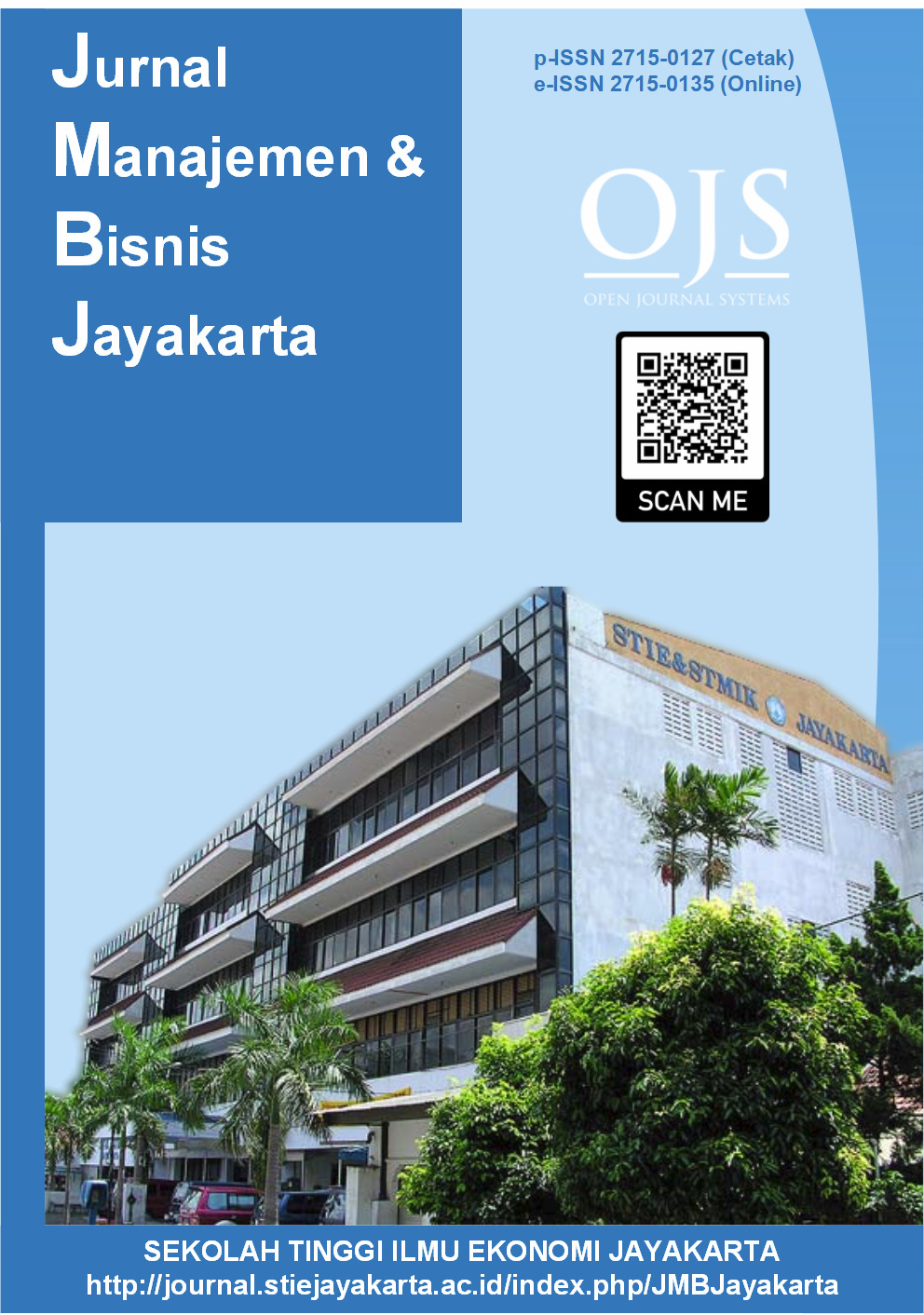INTENSI KONTINUITAS PENGGUNAAN DIGITAL PAYMENT: PERAN MAHASISWA SEBAGAI WARGA KEUANGAN DIGITAL
Abstract
This study aims to determine the factors that influence the level of continuance intention in using digital payments by students with the Expectation Confirmation Model (ECM) theory approach. The study used primary data from 100 students who use digital payments. The analysis in this study used SEM-PLS to analyze the relationship between exogenous variables and endogenous variables with the help of SmartPLS version 3. Overall, this model accounts for 54.7% of the variance in the continuity of digital payment usage intentions. An element substantially influenced by factors such as Perceived Usefulness and Satisfaction. Of these factors, Satisfaction is the most powerful predictor of continuance intention. Along with Confirmation, Perceived Usefulness also greatly affects Satisfaction. These findings will assist stakeholders in strategizing policies to offer more innovative and flexible technology products to the wider community as digital finance citizens.
References
Abrahão, R. de S., Moriguchi, S. N., & Andrade, D. F. (2016). Intention of adoption of mobile payment: An analysis in the light of the Unified Theory of Acceptance and Use of Technology (UTAUT). RAI Revista de Administração e Inovação, 13(3), 221–230. https://doi.org/10.1016/j.rai.2016.06.003
Al-Hattami, H. M. (2021). Determinants of intention to continue usage of online shopping under a pandemic: COVID-19. Cogent Business and Management, 8(1). https://doi.org/10.1080/23311975.2021.1936368
Alshurideh, M., Al Kurdi, B., & Salloum, S. A. (2019). Examining the main mobile learning system drivers’ effects: A mix empirical examination of both the Expectation-Confirmation Model (ECM) and the Technology Acceptance Model (TAM). International Conference on Advanced Intelligent Systems and Informatics, 406–417.
Ariffin, S. K., Abd Rahman, M. F. R., Muhammad, A. M., & Zhang, Q. (2021). Understanding the consumer’s intention to use the e-wallet services. Spanish Journal of Marketing - ESIC, 25(3), 446–461. https://doi.org/10.1108/SJME-07-2021-0138
Arifin, M. S., & Wahyuhastuti, N. (2022). Analisis Faktor-Faktor yang Mempengaruhi Intensitas Kontinuitas Pengguna E-Wallet Pada Mahasiswa Universitas PGRI Semarang. Jurnal Spirit Edukasia, 02(01), 76–87.
Bezhovski, Z. (2016). The Future of the Mobile Payment as Electronic Payment System. European Journal of Business and Management, 8(8), 127–132.
Bhattacherjee, A. (2001). Understanding information systems continuance: An expectation-confirmation model. MIS Quarterly: Management Information Systems, 25(3), 351–370. https://doi.org/10.2307/3250921
Chaveesuk, S., Khalid, B., & Chaiyasoonthorn, W. (2022). Continuance intention to use digital payments in mitigating the spread of COVID-19 virus. International Journal of Data and Network Science, 6(2), 527–536. https://doi.org/10.5267/j.ijdns.2021.12.001
Dahlberg, T., Mallat, N., Ondrus, J., & Zmijewska, A. (2008). Past, present and future of mobile payments research: A literature review. Electronic Commerce Research and Applications, 7(2), 165–181. https://doi.org/10.1016/j.elerap.2007.02.001
Davis, F. D. (1989). Perceived usefulness, perceived ease of use, and user acceptance of information technology. MIS Quarterly, 319–340.
Franque, F. B., Oliveira, T., & Tam, C. (2021). Understanding the factors of mobile payment continuance intention: empirical test in an African context. Heliyon, 7(8), e07807. https://doi.org/10.1016/j.heliyon.2021.e07807
Gong, X., Lee, M. K. O., Liu, Z., & Zheng, X. (2020). Examining the Role of Tie Strength in Users’ Continuance Intention of Second-Generation Mobile Instant Messaging Services. Information Systems Frontiers, 22(1), 149–170. https://doi.org/10.1007/s10796-018-9852-9
Gupta, A., Yousaf, A., & Mishra, A. (2020). How pre-adoption expectancies shape post-adoption continuance intentions: An extended expectation-confirmation model. International Journal of Information Management, 52(April 2019), 102094. https://doi.org/10.1016/j.ijinfomgt.2020.102094
Hair Jr, J. F., Hult, G. T. M., Ringle, C., & Sarstedt, M. (2016). A Primer on Partial Least Squares Structural Equation Modeling (PLS-SEM). SAGE Publications.
Halim, E., Chandra, A. N., Salim, J., Margarita, V., Destiano, R., & Hebrard, M. (2021). Predicting the determinants of continuance intention to use e-wallet in indonesia post-covid-19 pandemic. 2021 International Conference on Information Management and Technology (ICIMTech), 1, 545–550.
Jena, R. K. (2022). Investigating and Predicting Intentions to Continue Using Mobile Payment Platforms after the COVID-19 Pandemic: An Empirical Study among Retailers in India. Journal of Risk and Financial Management, 15(7), 314. https://doi.org/10.3390/jrfm15070314
Kaaronen, R. O. (2017). Affording sustainability: Adopting a theory of affordances as a guiding heuristic for environmental policy. Frontiers in Psychology, 8(NOV), 1–13. https://doi.org/10.3389/fpsyg.2017.01974
Kalinić, Z., Marinković, V., Kalinić, L., & Liébana-Cabanillas, F. (2021). Neural network modeling of consumer satisfaction in mobile commerce: An empirical analysis. Expert Systems with Applications, 175(March), 0–3. https://doi.org/10.1016/j.eswa.2021.114803
Nguyen, B. H., Zhuang, X., Wriggers, P., Rabczuk, T., Mear, M. E., & Tran, H. D. (2017). Isogeometric symmetric Galerkin boundary element method for three-dimensional elasticity problems. Computer Methods in Applied Mechanics and Engineering, 323, 132–150. https://doi.org/10.1016/j.cma.2017.05.011
Nikou, S. A. (2021). Web-based videoconferencing for teaching online: Continuance intention to use in the post-COVID-19 period. Interaction Design and Architecture(S), 47, 123–143.
Pal, A., Herath, T., De’, R., & Raghav Rao, H. (2021). Why do people use mobile payment technologies and why would they continue? An examination and implications from India. Research Policy, 50(6), 104228. https://doi.org/10.1016/j.respol.2021.104228
Park, E. (2020). User acceptance of smart wearable devices: An expectation-confirmation model approach. Telematics and Informatics, 47(September 2019). https://doi.org/10.1016/j.tele.2019.101318
Pricewaterhouse Coopers. (2019). It’s time for a consumer-centred metric: introducing ‘return on experience.’ Global Consumer Insights Survey.
Rabaa’i, A. A., & ALMaati, S. A. (2021). Exploring the Determinants of Users’ Continuance Intention to Use Mobile Banking Services in Kuwait: Extending the Expectation-Confirmation Model. Asia Pacific Journal of Information Systems, 31(2), 141–184. https://doi.org/10.14329/apjis.2021.31.2.141
Rahi, S., Othman Mansour, M. M., Alharafsheh, M., & Alghizzawi, M. (2021). The post-adoption behavior of internet banking users through the eyes of self-determination theory and expectation confirmation model. Journal of Enterprise Information Management, 34(6), 1874–1892. https://doi.org/10.1108/JEIM-04-2020-0156
Sari, R. K., Utama, S. P., & Zairina, A. (2021). The Effect of Online Shopping and E-Wallet on Consumer Impulse Buying. Asia Pacific Management and Business Application, 009(03), 231–242. https://doi.org/10.21776/ub.apmba.2021.009.03.3
Sarkar, S., Chauhan, S., & Khare, A. (2020). A meta-analysis of antecedents and consequences of trust in mobile commerce. International Journal of Information Management, 50(March 2019), 286–301. https://doi.org/10.1016/j.ijinfomgt.2019.08.008
Shaikh, A. A., & Karjaluoto, H. (2015). Mobile banking adoption: A literature review. Telematics and Informatics, 32(1), 129–142. https://doi.org/10.1016/j.tele.2014.05.003
Sharma, S. K., Mangla, S. K., Luthra, S., & Al-Salti, Z. (2018). Mobile wallet inhibitors: Developing a comprehensive theory using an integrated model. Journal of Retailing and Consumer Services, 45(June), 52–63. https://doi.org/10.1016/j.jretconser.2018.08.008
Singhania, M., & Saini, N. (2020). Revisiting environmental degradation and economic growth nexus using autoregressive distributed lag approach. International Journal of Productivity and Performance Management, 69(8), 1765–1796. https://doi.org/10.1108/IJPPM-10-2019-0509
Siyal, A. W., Ding, D., & Siyal, S. (2019). M-banking barriers in Pakistan: a customer perspective of adoption and continuity intention. Data Technologies and Applications, 53(1), 58–84. https://doi.org/10.1108/DTA-04-2018-0022
Suryanto, Herwan Abdul Muhyi, P. S. K. (2022). USE OF DIGITAL PAYMENT IN MICRO, SMALL AND MEDIUM BUSINESS. Jurnal Pemikiran Dan Penelitian Administrasi Bisnis Dan Kewirausahaan, 10(1), 1–52. https://doi.org/10.21608/pshj.2022.250026
Susanto, A., Chang, Y., & Ha, Y. (2016). Determinants of continuance intention to use the smartphone banking services: An extension to the expectation-confirmation model. Industrial Management and Data Systems, 116(3), 508–525. https://doi.org/10.1108/IMDS-05-2015-0195
Tam, C., Santos, D., & Oliveira, T. (2020). Exploring the influential factors of continuance intention to use mobile Apps: Extending the expectation confirmation model. Information Systems Frontiers, 22(1), 243–257. https://doi.org/10.1007/s10796-018-9864-5
Wang, T., Lin, C. L., & Su, Y. S. (2021). Continuance intention of university students and online learning during the covid-19 pandemic: A modified expectation confirmation model perspective. Sustainability (Switzerland), 13(8). https://doi.org/10.3390/su13084586
Copyright (c) 2023 Erlinda Sholihah, Diyah Ariyani

This work is licensed under a Creative Commons Attribution-NonCommercial-ShareAlike 4.0 International License.















